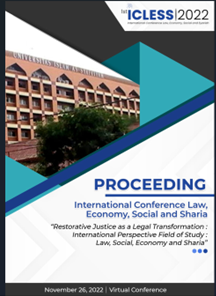Review on Restorative Justice Approach in The Settlement of Sexual Violence Cases
Keywords:
restorative justice, sexual violence, gender-based violenceAbstract
According to the 2018-2020 Annual Record (CATAHU) of Komnas Perempuan, sexual violence against women, such as incest, cyber sexual violence, marital rape, fornication, and rape, happens often in personal/private and community settings. Sexual violence causes in material, physical, and psychological damages for the victim. However, when solving it, many people remain to consider it trivial. When restorative justice used to resolve the case, often, the solutions to resolve cases of sexual violence pay less attention to the condition of the victim. This paper analyzes whether the pursuit of restorative justice is an appropriateresponse for victims of sexual violence. The pursuit of restorative justice is one of many ambitious strategies to reform criminal justice mechanisms. This becomes increasingly problematic when the indicator of restorative justice is unclear. The method used in this study is a qualitative approach, namely the normative method. through library research. The primary purpose of the restorative justice approach is to reduce the jail population. Therefore, it is resolved as peacefully as possible (via mediation) with the aim of restoring the situation to its original state and reestablishing the pattern of good relations in society. In cases of sexual violence, the victim suffers not only physical and material losses, but also psychological and social ones. Whether then this Restorative Justice can protect victims and ensure their rights is still a questionable. Physical and monetary losses may be recoverable in a short period of time, but psychological trauma might last a lifetime. In addition, there is no assurance that the offender will not threaten the victim or even repeat his crimes once the Restorative Justice process has been concluded.



